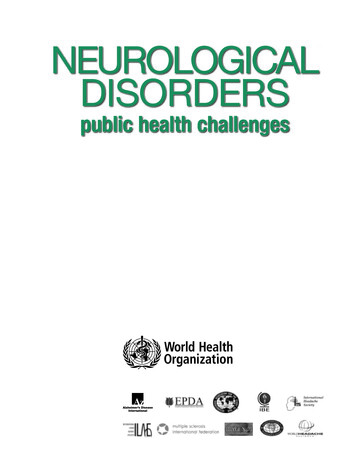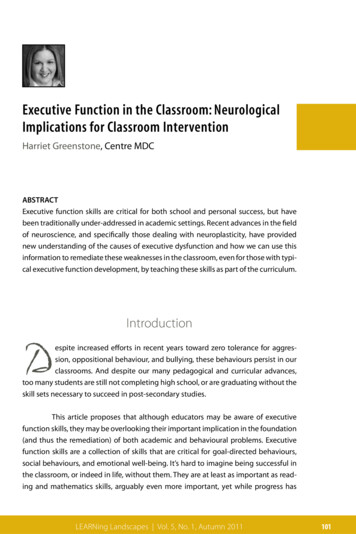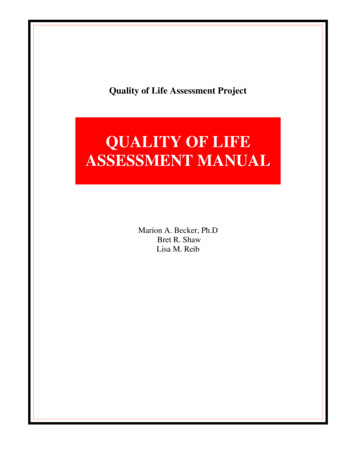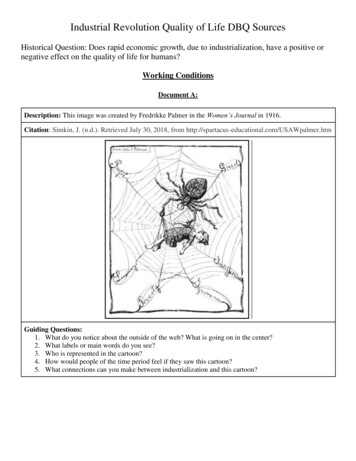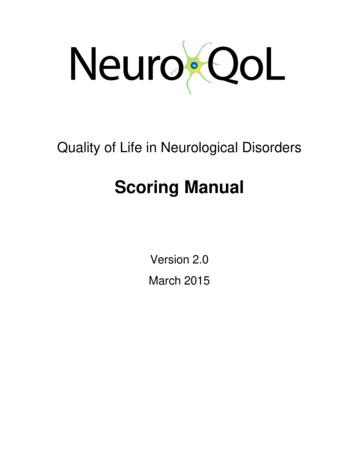
Transcription
Quality of Life in Neurological DisordersScoring ManualVersion 2.0March 2015
Table of ContentsScoring Options . 4Scoring Service . 4How to use the HealthMeasures Scoring Service, powered by Assessment Center . 4The HealthMeasures Scoring Service is especially useful when: . 4Manual Scoring . 4Instructions for Manual Scoring . 4Managing Missing Data . 4Scoring Scales (Uncalibrated Sets of Items) . 5Meaning of T-Scores . 5Reference Populations . 5Table 1: Direction of Neuro-QoL Scores. 6Version 1 vs Version 2 Measures . 6Scoring Tables . 7Table 2: Adult Anxiety . 7Table 3: Adult Depression . 8Table 4: Adult Fatigue . 8Table 5: Adult Upper Extremity Function – Fine Motor, Activities of Daily Living . 9Table 6: Adult Lower Extremity Function – Mobility. 9Table 7: Adult Cognitive Function v2.0 . 10Table 8: Adult Applied Cognition – Executive Function v1.0 . 10Table 9: Adult Applied Cognition – General Concerns v1.0 . 11Table 10: Adult Emotional and Behavioral Dyscontrol . 11Table 11: Adult Positive Affect and Well-Being . 12Table 12: Adult Sleep Disturbance . 12Table 13: Adult Ability to Participate in Social Roles and Activities (English) . 13Table 14: Adult Ability to Participate in Social Roles and Activities (Spanish) . 13Table 15: Adult Satisfaction with Social Roles and Activities. 14Table 16: Adult Stigma . 14Table 17: Pediatric Stigma. 15Table 18: Pediatric Depression . 15Table 19: Pediatric Anxiety . 16Table 20: Pediatric Social Relations-Interaction with Peers . 16Table 21: Pediatric Cognitive Function . 172
Table 22: Pediatric Fatigue v2.1 (11-item bank version). 17Table 23: Pediatric Fatigue v1.0 . 18Table 24: Pediatric Pain. 19Table 25: Pediatric Anger . 203
Scoring OptionsWhen data are collected through Assessment Center and the Assessment Center API (including users of theAPI like REDCap), Neuro-QoL computer adaptive tests (CATs) and short forms are automatically scored. Whendata are collected on paper or in other data collection systems, you can either utilize the Scoring Service orcalculate scores by hand.Scoring ServiceThe Scoring Service is a free, web-based application that calculates scores using item response theory. Eachresponse to each item is utilized. It is the most accurate scoring method. The output of the Scoring Serviceincludes Theta, T-score, and standard error for each respondent at each time point.How to use the HealthMeasures Scoring Service, powered by Assessment Center1. Download the Input Template from the top right corner of the website.2. Add your data (all respondents’ individual answers to questions) for one Neuro-QoL measure to thetemplate (multiple timepoints are okay)3. Upload your spreadsheet to the HealthMeasures Scoring Service (if this is your first time, register as anew user)4. Access your email to receive a spreadsheet with calculated scoresThe HealthMeasures Scoring Service is especially useful when: You administered a short form, but not all participants answered every questionDifferent groups of participants responded to different itemsYou have created a new questionnaire using a subset of questions from one Neuro-QoL item bankManual ScoringIf you are not able to use the Scoring Service, you can calculate scores by hand. This is only available forexisting short forms. CATs and custom short forms you constructed by selecting items from an item bankcannot use manual scoring.Instructions for Manual ScoringFor a given short form, each response option is assigned a value (e.g., 1 Not at all). The PDF version of thatmeasure has the correct values for each response option. You need to calculate a total summed raw score foreach respondent. To find the total raw score, sum the values of the response to each question. For example, foran 8-item form that includes items with 5 response options ranging from 1 to 5, the lowest possible raw score is8 (8 x 1) ; the highest possible raw score is 40 (8 x 5).Use the conversion tables below to translate the total raw score into an IRT-based T-score for each participant.These conversions are accurate when all questions on the short form have been answered. Using Anxiety shortform as an example, which contains 8 items for both adult and pediatric versions, for adults, a raw score of 8converts to a T-score of 36.4 with a standard error of 5.2. In order to calculate the 95% confidence interval for ascore, you should use the following formula: T-Score /- (1.96 x SE). Thus, for this example, we can say with95% confidence that the actual score is within 1.96 x 5.2 or T- Score 36.4 /- 10.2 26.2 to 46.6.Managing Missing DataA score can be approximated if a participant skips a question. If items are missing, first check how many itemswere answered. For short forms with at least 5 items, confirm that 4 or 50% of items, whichever is greater, havebeen answered. For example, a 4-item short form can only be scored with responses to all 4 items. A 10-itemshort form can be scored as long as the participant answered at least 5 items. After confirming that enough4
responses were provided, sum the response scores from the items that were answered. Multiply this sum by thetotal number of items in the short form. Finally, divide by the number of items that were answered. For example,if a respondent answered 5 of 8 questions and answered all items with the second lowest response option (2),you would sum all responses (10), multiply by the number of items in the short form (8) and divide by thenumber of items that were actually answered (5). Here (10x8)/5 16. If the result is a fraction, round up to thenearest whole number. This is a prorated raw score. However, this prorated score should be used with cautionas the advantages of IRT calibrations and their contribution to precision is lost in the process.Scoring Scales (Uncalibrated Sets of Items)Scales (i.e., uncalibrated sets of items) can be scored by summing the values of the response to each item (i.e.,finding the total raw score). For the 20-item pediatric Lower Extremity Function - Mobility, and Upper ExtremityFunction scales, the range of responses is 0 to 4, with 0 being the worst possible total score and 80 being thebest. A score is obtained by adding up the values of the response to each question, then multiplying the total sumby 100 and dividing by 80, or Summed score X100/80.If there are missing responses, multiply the sum of the item scores by the number of items in the subscale, thendivide by the number of items answered, to obtain a prorated score. However, as explained above, this shouldbe done only if at least half of the items were completed (e.g., at least 10 of the 20 items were answered). In thecase of the adult 5-item Communication scale, when all five items are answered, the score is obtained by addingup the values of the response to each question, then subtracting 5 from the total sum, multiplying by 100 anddividing by 20, or (Summed score - 5) X100/20. In the case of 4 out of 5 questions being answered, a score canstill be derived by prorating the sum score first, and then converting to the 0-100 scale. The prorated sum isobtained by multiplying the sum of the item scores by 5, then dividing by 4. Then, subtract 5 from the totalprorated sum, multiply by 100 and divide by 20. Thus, when 4 of 5 items were answered, the 0-100 score iscomputed algebraically as:[(Raw sum score X 5 / 4) – 5] X 100/20We do not recommend prorating in cases where fewer than 4 of 5 (or 6) questions (or fewer than 50% of the totalnumber of questions for scales longer than 6 items) have been answered.Meaning of T-ScoresT-score distributions rescale raw scores into standardized scores with a mean of 50 and a standard deviation(SD) of 10. Thus, a person who has a T-score of 60 is one SD above the average of the referenced populations,either the US general population or clinical populations.Important: A higher Neuro-QoL T-score represents more of the concept being measured. For positively-wordedconcepts like Ability to Participate in Social Roles and Activities, a T-score of 60 is one SD better than average.By comparison, for symptoms and other negatively-worded concepts like Fatigue and Depression, a T-score of60 is one SD worse than the averaged reference population.Reference PopulationsFor adults, a clinical reference population was used for Stigma, Fatigue, Emotional and Behavioral Dyscontrol,and Sleep Disturbance measures. All other adult measures used a general population reference sample. Forchildren, a clinical reference population was used for stigma and pain measures. All other pediatric measuresused a general reference population. Please note that, different from version 1, pediatric Fatigue and CognitiveFunction were re-calibrated using a general population.5
Table 1: Direction of Neuro-QoL ScoresHigh scores indicate worse(undesirable) self-reportedhealthHigh scores indicate better(desirable) self-reportedhealthDomainsAnxiety, Depression, Anger, Fatigue, Emotional and Behavioral Dyscontrol,Sleep Disturbance, Stigma, PainUpper Extremity Function – Fine Motor, ADL, Lower Extremity Function Mobility, Cognitive Function, Positive Affect and Well-Being, Ability toParticipate in Social Roles and Activities, Satisfaction with Social Roles andActivities, Social Relations – Interaction with Peers, Social Relations –Interaction with Adults, CommunicationVersion 1 vs Version 2 MeasuresInstead of two item banks (version 1) to assess adult cognitive function (Applied Cognition – Executive Functionand Applied Cognition – General Concerns), version 2 has a single Cognitive Function item bank comprised ofitems measuring both executive function a
You administered a short form, but not all participants answered every question Different groups of participants responded to different items You have created a new questionnaire using a subset of questions from one Neuro-QoL item bank . Manual Scoring If you are not able to use the Scoring Service, you can calculate scores by hand. This is only available for existing short forms .
